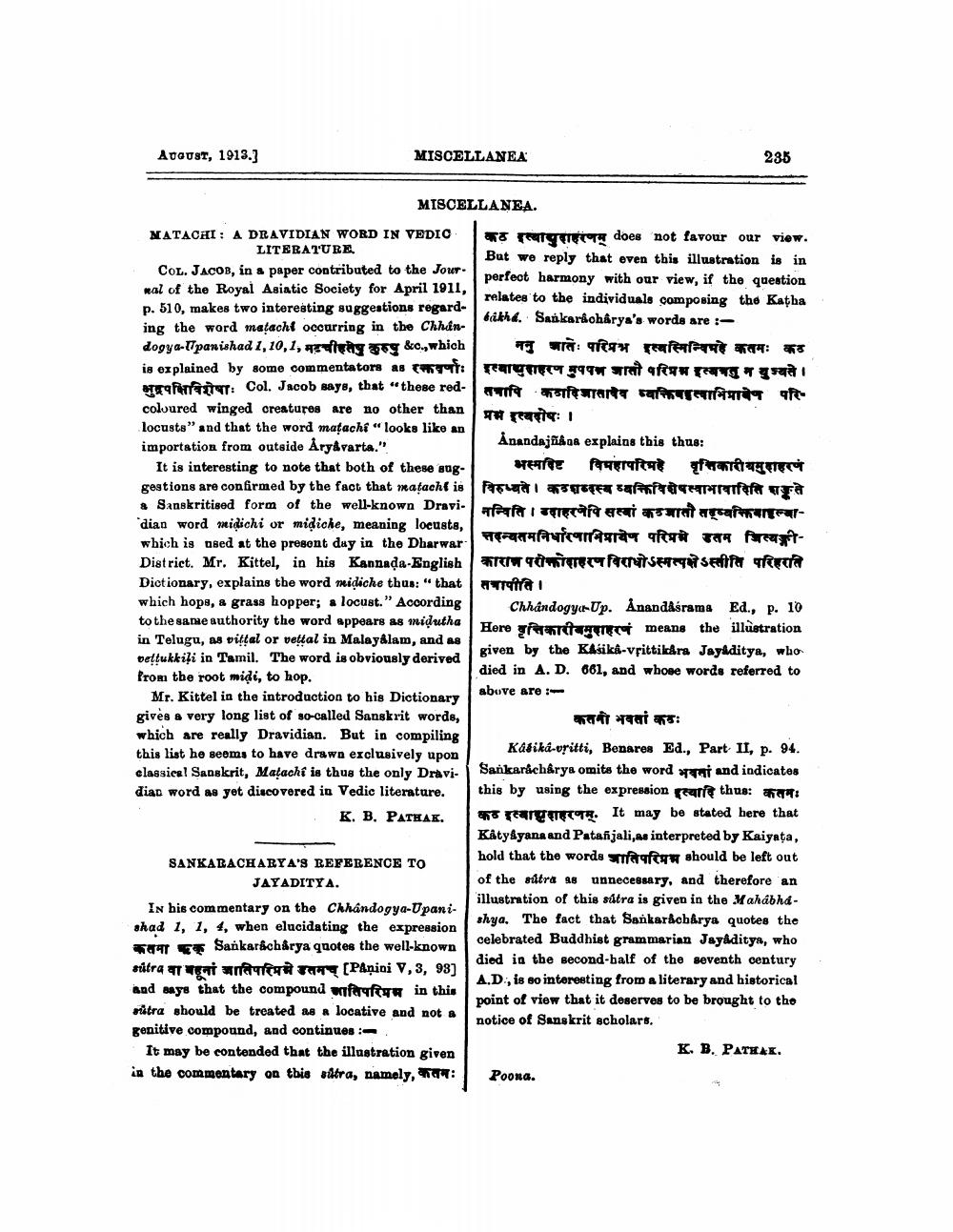________________
AUGUST, 1913.]
MISCELLANEA
235
MISCELLANEA.
H
NATACHI: A DRAVIDIAN WORD IN VEDIO
| कठ बत्वापुसाहरणम् does not tavour our view. LITERATURE
But we reply that even this illustration is in COL. JACOB, in a paper contributed to the Jour.
perfect harmony with our view, if the question xal of the Royal Asiatic Society for April 1911,
relates to the individuals composing the Katha p. 510, makes two interesting suggestions regard
labhd. Sankaracharya's words are :ing the word matacht occurring in the Chhandogya-Upanishad 1,10,1, catal &o., which मनु जातेः परिप्रभ इस्वस्मिन्विमहे कतमः कट is explained by some commentators as : इस्वायुनाहरण मुपपनजाती परिप्रमहत्वातुम बुज्यते । O T: Col. Jacob says, that these red
तथापि कादिशाताव व्यक्तिपात्वाभिप्रायेण परिcoloured winged creatures are no other than
| प्रम इत्वदोषः । locusts" and that the word maçachf " looks like an importation from outside Aryavarta.".
Anandajfikoa explains this thus: It is interesting to note that both of these sog. भस्मविष्ट विमहापरिमहे वृतिकारीबमुहाहरणं gestions are confirmed by the fact that matachi is proui ETF Efferrafata * Sanskritised form of the well-known Dravi.
मन्विति । उदाहरणेपि सत्वां करमाती तब्यक्तिबाल्बा'dian word midichi or midiche, meaning locusts, which is used at the present day in the Dharwar
तदन्यतमनिर्धारणानिमावेष परिममे उतम जित्यजीDistrict. Mr. Kittel, in his Kannada-English | काराण परोक्कोसाहरणविराधोऽस्मत्पोऽस्तीति परिहरति Dictionary, explains the word midiche thus that trai which hops, & grass hopper; a locust." According
Chhandogya-Up. Anandåśrama Ed., p. 10 to the same authority the word appears as midutha
Here gardagueri means the illustration in Telugu, as vittal or vettal in Malayalam, and as
given by the Kasika-vfittikara Jayaditya, who vettukkisi in Tamil. The word is obviously derived from the root midi, to hop.
died in A. D. 661, and whose words referred to Mr. Kittel in the introduction to his Dictionary
above are : gives a very long list of so-called Sanskrit words,
Tips: which are really Dravidian. But in compiling this list he seems to have drawn exclusively upon
Katika-vritti, Benares Ed., Part II, p. 94. classical Sanskrit, Malachi is thus the only Drávidiad word as yet discovered in Vedic literature. this by using the expression rear thus: :
K. B. PATHAK. year T TH. It may be stated here that
Katyayana and Patañjali,as interpreted by Kaiyata,
hold that the words SANKARACHARYA'S REFERENCE TO
af should be left out JAYADITYA.
of the stra es unnecessary, and therefore an In his commentary on the Chhandogya-Upani
illustration of this sútra is given in the Mahabha
shya. The fact that Sankaracharya quotes the shad 1, 1, 4, when elucidating the expression
celebrated Buddhist grammarian Jayaditya, who 1 x Sankaracharya quotes the well-known
died in the second-half of the seventh century sritra वा बहूनां जातिपरिममे उतमच (Panini V, 3, 98]
A.D., is so interesting from a literary and historical and says that the compound unferafiya in this
point of view that it deserves to be brought to the nitra should be treated as a locative and not a
notice of Sanskrit scholars, genitive compound, and continues :It may be contended that the illustration given
K. B. PATHAK. in the commentary on this sitra, namely, T: Poona.




